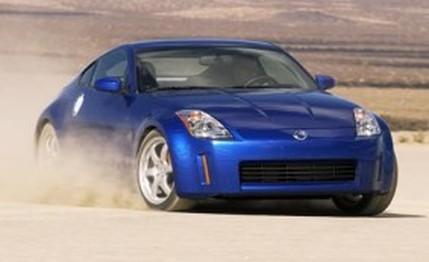 First Drive Review
First Drive Review
Nissan has the worst luck with timing. The company introduced its last 300ZX and 300ZX Turbo models for 1990, shortly before the sports-car market -- and the economy -- began to crash-dive. Now, just back from its honeymoon with Renault, Nissan has previewed a brave new Z-car that will likely be available in both coupe and convertible forms. Although it's not scheduled to show up until midway through 2002, all the current economic indicators suggest we're about to slip into another downturn.
It doesn't necessarily follow that the new Z-car will tank, but you have to feel for these guys -- particularly after seeing what a cool little car it is. The company's American design office in La Jolla, California, which is now called Nissan Design America, gets credit for the car. The Z concept shown here suggests the new car will return to the compact dimensions and volumes of the earliest Z-cars, while carrying design cues from both the early 240Z and recent 300ZX series. Its very stubby length-to-track relationship gives this new Z a stance as squat as a snowboard boot and makes it resemble the Audi TT. The headlights and the hood are reminiscent of Toyota's Celica because of the accent lines and the peeled-back lenses, but the car's general look is very much its own -- particularly the rear deck, which follows the steep roofline and then drops in two distinct stages. The chief designer of Nissan's Red Studio at NDA, Diane Allen, says the deck shape is aerodynamically sound and requires neither a static nor articulating spoiler.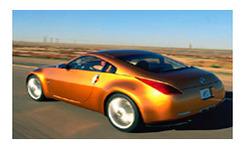
Despite a deliberate attempt to evoke the previous 300ZX's C-pillar, the designers have provided a totally contemporary flavor to the overall appearance. According to Nissan's design director, Shiro Nakamura, the new Z was specifically intended not to be a retro design. "It's a new interpretation of the Z-car," he said, "and we believe it will exceed customers' expectations." Nakamura also cites something called "Z DNA," which he says is the combination of passion, performance, and practicality that has always driven the Nissan Z-car designs of the past. With the new car, he hopes those virtues can be combined with the practical side of everyday ownership -- durability, comfort, utility, and low maintenance. With a price target believed to be less than $30,000, the new Z looks poised to test that assumption. Designed from the outset to be a convertible as well as a true hatchback coupe, we hear tell that the new Z may be launched simultaneously in both forms. 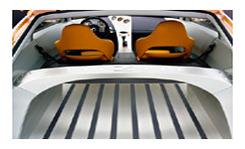
When it arrives, the new Z will be powered by a more highly tuned version of the so-called VQ35DE 3.5-liter V-6 engine now found in the Nissan Pathfinder and Infiniti QX4 SUVs. Expected to produce 260 or so horsepower when hooked to a manual transmission -- the Z (which is unlikely to wear an alphanumeric label such as 350Z or 350ZX) will undoubtedly offer a broad spread of torque throughout its range. After all, the Pathfinder already boasts 250 hp at 6000 rpm (240 with an automatic transmission), and there's clearly more to be had without compromising the current engine's excellent torque spread. Right now the boffins at Nissan are saying the new Z will be good for a 0-to-60 time of less than six seconds, and that looks entirely feasible if the show car's meaty tires -- 275/35 rear, 255/35 front -- and 20-inch wheels (or something comparable to them) make it into production. The power will reach the 35-series rear tires via a six-speed manual or five-speed electronically controlled automatic transmission, which will probably have some kind of manumatic override system. In the show car, the shifter is located in a ramp-shaped center console that evokes the previous-generation 300ZX's cockpit.
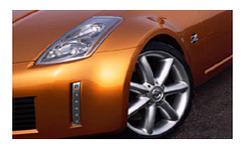
In this particular show vehicle, the interior design is highly stylized, and we expect that the production vehicles will follow the general themes explored here. Although the motorcycle-style speedometer and tach are suitably contemporary, the three gauge pods in the center console reiterate the look of the original 240Z design. Despite its clean minimalism, the dash allows for the inclusion of a navigation-system display panel. Once seated in the new Z, a driver quickly appreciates that this is not a two-plus-two design. The roofline dives abruptly from a point just behind the driver's head, and the interior is as snug as that of an old air-cooled Porsche 911. According to Allen, the design team deliberately rejected the idea of long doors to avoid any suggestion that there was access to rear seats. "The cabin is purposely selfish," she says. So, instead of rear seats, this Z sports a silver-colored luggage compartment with prominent longitudinal ribs. Also prominent is an aluminum strut-tower brace, complete with Z logo, that bridges the wheel housings and is clearly visible through the rear window. "It's like looking at jewelry through a display case," says Allen. In this Detroit-debut show car, the seats are aggressively bolstered units in a saddle color that contrasts sharply with the high-tech silver and black interior panels. As in Ferrari's 360, the center console is a cast aluminum piece, and the door vents are similarly metallic. 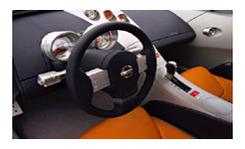
It is unlikely that there will ever be a turbocharged version of Nissan's new Z, or a four-wheel-steer model as there was in the previous generation. And there is no word yet whether high-tech gadgetry such as stability control or a variable suspension will ever be brought on board. Our guess is that Nissan will keep it simple this time. If it does, the car will be sticking with the original Z concept. Hey, there wasn't much wrong with that.